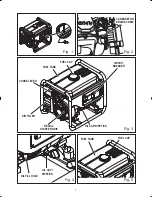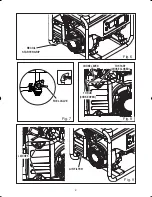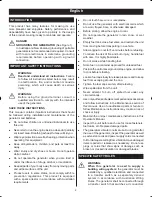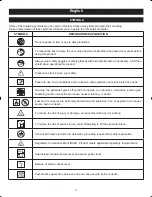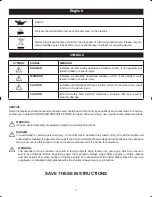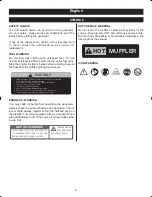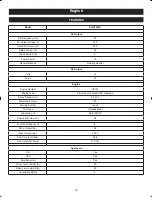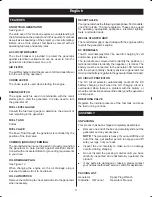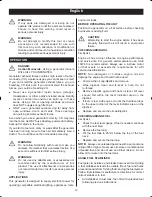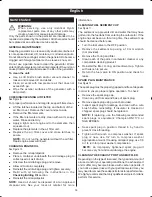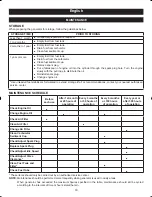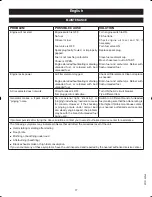
12
English
WARNING:
If any parts are damaged or missing do not
operate this product until the parts are replaced.
Failure to heed this warning could result in
serious personal injury.
WARNING:
Do not attempt to modify this tool or create
accessories not recommended for use with
this tool. Any such alteration or modification is
misuse and could result in a hazardous condition
leading to possible serious personal injury.
OPERATION
DANGER:
Carbon Monoxide.
Using a generator indoors
WILL KILL YOU IN MINUTES.
Generator exhaust fumes contains high levels of carbon
monoxide (CO), a poisonous gas you cannot see or smell.
If you can smell the generator exhaust fumes, you are
breathing CO. But even if you cannot smell the exhaust
fumes, you could be breathing CO.
n
Never use a generator inside homes, garages,
crawlspaces, or other partly enclosed areas. Deadly
levels of carbon monoxide can build up in these
areas. Using a fan or opening windows and doors
does NOT supply enough fresh air.
n
ONLY use a generator outdoors and far away from
open windows, doors, and vents. These openings
can pull in generator exhaust fumes.
Even when you use a generator correctly, CO may leak
into the home. ALWAYS use a battery-powered or battery-
backup CO alarm in the home.
If you start to feel sick, dizzy, or weak after the generator
has been running, move to fresh air immediately. See a
doctor. You could have carbon monoxide poisoning.
WARNING:
Do not allow familiarity with tools to make you
careless. Remember that a careless fraction of a
second is sufficient to inflict serious injury.
WARNING:
Do not use any attachments or accessories not
recommended by the manufacturer of this
product. The use of attachments or accessories
not recommended can result in serious personal
injury.
APPLICATIONS
This generator is designed to supply electrical power for
operating compatible electrical lighting, appliances, tools,
and motor loads.
BEFORE OPERATING THE UNIT
Position the generator on a flat surface before checking
fluid levels or adding fluid.
CAUTION:
Attempting to start the engine before it has been
properly filled with oil will result in equipment
failure.
CHECKING/ADDING OIL
See Figure 4.
Engine oil has a major influence on engine performance
and service life. For general, all-temperature use, SAE
10W-30 is recommended. Always use a 4-stroke motor
oil that meets or exceeds the requirements for API
service classification SJ.
NOTE:
Non-detergent or 2-stroke engine oils will
damage the engine and should not be used.
n
Unscrew the oil cap/dipstick and remove.
n
Wipe dipstick clean and re-seat in hole; do not
re-thread.
n
Remove dipstick again and check oil level. Oil level
should fall within the level indicator area on the
dipstick.
n
If level is low, add engine oil until the fluid level rises
to the upper portion of the level indicator area on the
dipstick.
n
Replace and secure the oil cap/dipstick.
CHECKING/ADDING FUEL
See Figure 5.
n
Check the fuel level gauge. If fuel is needed, continue
with the next step.
n
Remove the fuel cap.
n
Fill the fuel tank to 25mm below the top of the fuel
neck.
n
Replace and secure the fuel cap.
NOTE:
Always use unleaded gasoline with a pump octane
rating of 86 or higher. Never use old, stale, or contaminated
unleaded fuel, and do not use an oil/fuel mixture. Do not
allow dirt or water into the fuel tank.
USING FUEL STABILISER
Fuel gets old, oxidizes, and breaks down over time. Adding
a fuel stabiliser extends the usable life of fuel and helps
prevent deposits from forming that can clog the fuel system.
Follow fuel stabiliser manufacturer’s directions for correct
ratio of stabiliser to fuel.
n
Add stabiliser to fuel tank, then fill with unleaded fuel
following previous instructions.


